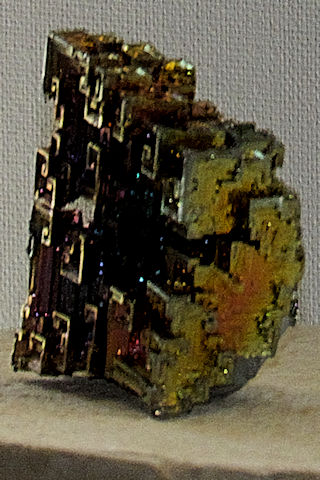 |
| bismuth crystal |
My wife said, "Twenty dollars for a rock?! And not even natural."
It's true; bismuth generally doesn't crystallize like this in nature; only in a lab. Bismuth, with a melting point of 520 degrees Fahrenheit melts at a lower temperature than lead, which melts at 621 degrees, but higher than tin which at 450 degrees melts at a temperature lower than paper combusts, according to Ray Bradbury, author of "Fahrenheit 451".
As a child I owned a dangerous toy, used to turn solid lead into toy soldiers. We kids marveled as the hot lead liquefied and somehow we managed to pour it into molds without serious injury. Later in college I bought a torch, tongs, crucible, and scrap silver. Sterling silver melts at 1,640 degrees, far lower than molybdenum, which melts at 4,760 degrees, but still plenty hot. Hot enough, that I was having trouble keeping it liquid while gradually adding metal to the crucible. When I heard the crucible loudly crack I abandoned the effort. Remembering the accident that ruined the young silversmith's hand in the book, "Johnny Tremain". I considered myself lucky. When the crucible cooled, a dull, glassy, flux coated silver lump remained.
Since bismuth can be melted on a kitchen stove, making bismuth crystals would be a cool science project. However, I don't know of any elementary school that would allow kids to try this in a classroom. Ken K. has been making bismuth crystals for over sixteen years using a scientific hotplate. He wears a respirator and safety glasses as a precaution. Hot metal can spatter. Some beautiful examples can be found on Ken's website*. Ken has perfected his own techniques which he won't divulge since that would be, "like Willy Wonka giving out his recipe for Everlasting Gobstoppers."
*Ken K's website is no longer active DL 2021

I really like this story. It is really interesting
ReplyDelete